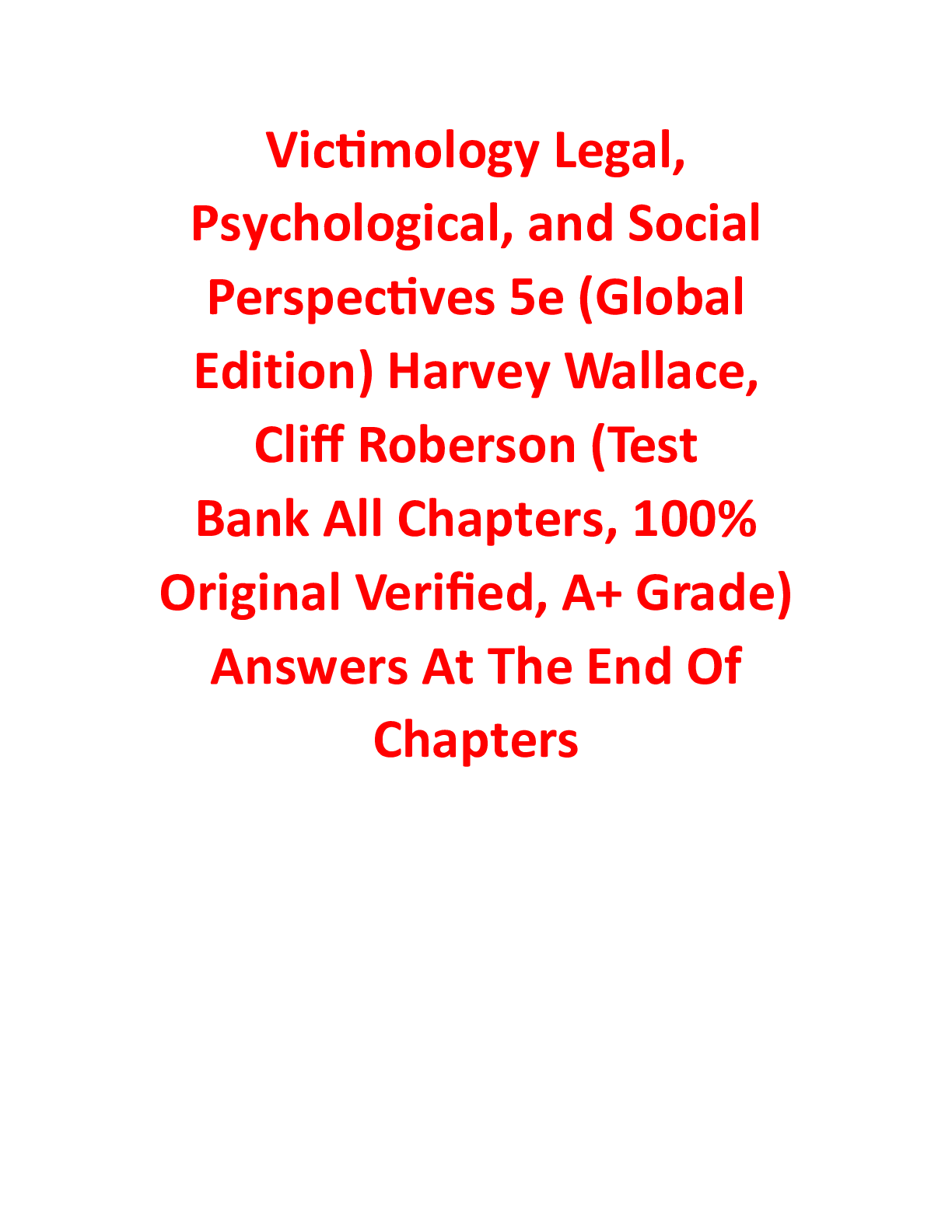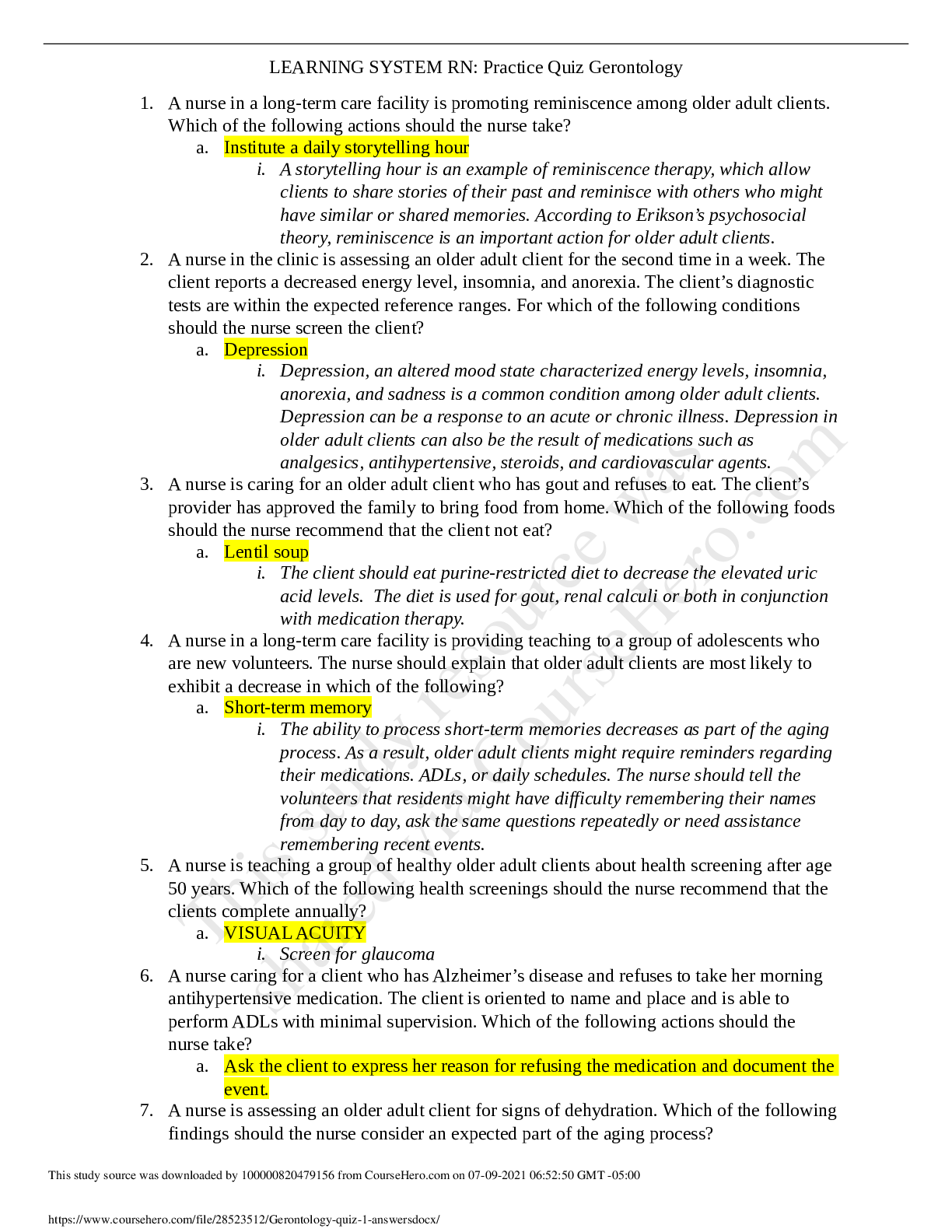
Test Bank For Victimology Legal, Psychological, and Social Perspectives 5th Edition (Global Edition) By Harvey Wallace, Cliff Roberson
*NURSING > EXAM > LEARNING SYSTEM RN: Practice Quiz Gerontology 2020 with complete solution:chamberlain college (All)
LEARNING SYSTEM RN: Practice Quiz Gerontology 2020 with complete solution:chamberlain college 1. A nurse in a long-term care facility is promoting reminiscence among older adult clients. Which of the ... following actions should the nurse take? 2. A nurse in the clinic is assessing an older adult client for the second time in a week. The client reports a decreased energy level, insomnia, and anorexia. The client’s diagnostic tests are within the expected reference ranges. For which of the following conditions should the nurse screen the client? 3. A nurse is caring for an older adult client who has gout and refuses to eat. The client’s provider has approved the family to bring food from home. Which of the following foods should the nurse recommend that the client not eat? 4. A nurse in a long-term care facility is providing teaching to a group of adolescents who are new volunteers. The nurse should explain that older adult clients are most likely to exhibit a decrease in which of the following? 5. A nurse is teaching a group of healthy older adult clients about health screening after age 50 years. Which of the following health screenings should the nurse recommend that the clients complete annually? 6. A nurse caring for a client who has Alzheimer’s disease and refuses to take her morning antihypertensive medication. The client is oriented to name and place and is able to perform ADLs with minimal supervision. Which of the following actions should the nurse take? 7. A nurse is assessing an older adult client for signs of dehydration. Which of the following findings should the nurse consider an expected part of the aging process? 8. A nurse is providing discharge instructions about calcium supplements to an older adult female client who has osteoporosis and a recent repair of a fracture in her right hip. Which of the following instructions should the nurse include? 9. A nurse is caring for an older adult client who has pneumonia. Which of the following physiologic changes associated with aging places the client at risk for pneumonia? 10. A nurse is planning care for a client who had a stroke. Which of the following goals should the nurse identify as the priority for this client? 11. A nurse is conducting an admission assessment for an older adult client. Which of the following actions should the nurse take to collect subjective data? 12. A nurse is caring for an adult client. Which of the following physiologic changes associate with aging can affect medication dosage in this client? 13. A nurse is caring for an older adult client who has a new onset of type 2 diabetes mellitus. Which of the following physiologic changes can contribute to the development of type 2 diabetes? 14. A nurse at an assisted living center is conducting an orientation session for a group of newly hired assistive personnel. Which of the following instructions should the nurse include regarding clients who are hearing impaired? 15. A nurse is caring for an older adult client who has dementia. The client becomes agitated and confused at night and wanders into the hallway. Which of the following actions should the nurse take? 16. An older adult client tells a nurse at a health fair “I am always forgetting things. I cannot even remember where I parked my car! Do you think I have Alzheimer’s disease?” Which of the following is a therapeutic response by the nurse? 17. A nurse is participating on a committee that is developing age-appropriate care standards for older adult clients. Which of the following Erikson’s development tasks should the nurse recommend as the focus? 18. A nurse is planning to administer diphenhydramine hydrochloride to an older adult client. Which of the following actions should the nurse plan to take prior to administration? 19. A nurse is developing a plan of care for a client who had a recent stroke and has a history of gastroesophageal reflux (GERD). For which of the following disorders should the nurse plan to monitor this client? 20. A nurse at an ophthalmology clinic is assessing a client referred by the provider for a potential cataract. Which of the following client reports should the nurse recognize is consistent with cataracts? 21. A nurse is teaching a newly hired assistive personnel about her role in helping older adult clients with activities of daily living. The nurse should explain that which of the following is the most common factor that affects a client’s performance of ADLs? 22. A nurse is teaching a group of older adult female clients who are postmenopausal about dietary requirements. Which of the following statements about the role of folic acid should the nurse make? 23. A home health nurse is visiting an older adult client who has anemia. Which of the following foods should the nurse recommend to increase the client’s iron intake? 24. A nurse is teaching an older adult client who is on bedrest following development of deep vein thrombosis about methods to increase peristalsis. Which of the following high-fiber food choices should the nurse recommend? 25. A nurse is assessing an older adult client during an annual physical. Which of the following client findings should the nurse report to the provider? 26. A nurse reviewing he medical record of a client who is postmenopausal and has osteoporosis. The client has a new prescription for alendronate sodium. Which of the following findings in the client’s history should the nurse recognize is a contraindication to this medication? 27. A nurse is planning care for an older adult client following abdominal surgery for a bowel obstruction. Which of the following information about pain management should the nurse consider when planning care? a. Older adult clients are sensitive to the analgesic effect of opiates 28. A nurse is providing teaching to an older adult client who has osteoarthritis of the right hip and lower lumbar vertebrae which of the following statements by the client indicates an understanding of the teaching? 29. A nurse is assessing an older adult client who states he is homeless. Which of the following findings should the nurse document as comorbidities for this client? 30. A nurse admitting an older adult client who fell at home 3 days ago. The client has a fractured hip, malnutrition, and dehydration. Which of the following laboratory values noted on admission, should indicate to the nurse prolonged malnutrition? [Show More]
Last updated: 3 years ago
Preview 1 out of 4 pages

Buy this document to get the full access instantly
Instant Download Access after purchase
Buy NowInstant download
We Accept:

Can't find what you want? Try our AI powered Search
Connected school, study & course
About the document
Uploaded On
Oct 17, 2020
Number of pages
4
Written in
All
This document has been written for:
Uploaded
Oct 17, 2020
Downloads
0
Views
181
Scholarfriends.com Online Platform by Browsegrades Inc. 651N South Broad St, Middletown DE. United States.
We're available through e-mail, Twitter, Facebook, and live chat.
FAQ
Questions? Leave a message!
Copyright © Scholarfriends · High quality services·